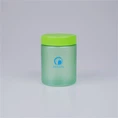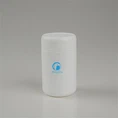What Is Moisture Barrier Performance?
Moisture barrier refers to a material's ability to resist the penetration of water vapor. A strong moisture barrier is essential for products sensitive to humidity, especially in the pharmaceutical, food, and supplement industries. The standard measurement for this property is Water Vapor Transmission Rate (WVTR) - the lower the WVTR, the better the moisture protection.
HDPE: Strong Moisture Resistance
HDPE has a dense, crystalline structure that gives it inherently strong moisture resistance. Here are its key advantages:
Low WVTR: HDPE has a significantly lower water vapor transmission rate compared to many other plastics, including PET.
Ideal for Dry Products: Commonly used for tablets, powders, and capsules where moisture can degrade product quality.
Chemical Resistance: In addition to moisture protection, HDPE resists acids, alkalis, and many solvents, making it reliable for sensitive contents.
PET: Moderate Moisture Barrier with Visual Advantages
PET is valued for its clarity and rigidity, often used in applications where visual presentation matters. However, its moisture barrier performance is moderate:
Higher WVTR than HDPE: PET does not block moisture as effectively as HDPE, especially in high-humidity environments.
Best for Visual and Liquid Packaging: PET is ideal for products like gummies, softgels, and beverages where transparency is important.
Enhanced with Seals: While PET alone has a higher WVTR, using induction seals or foil liners can significantly improve its barrier properties.
Side-by-Side Comparison: PET vs. HDPE
| Property | HDPE | PET |
|---|---|---|
| Moisture Resistance | Excellent (Low WVTR) | Moderate (Higher WVTR) |
| Transparency | Opaque | Clear |
| Impact Strength | Moderate | High |
| Best For | Dry, moisture-sensitive items | Visual display, liquids |
Which Material Should You Choose?
For moisture-sensitive products such as capsules, tablets, or dry powders → HDPE is the safer choice, especially when paired with airtight caps and liners.
For visual appeal or branding - such as displaying gummies or colorful softgels → PET is preferred, and its barrier performance can be enhanced with proper sealing methods.
For export or long-distance shipping → HDPE offers more consistent protection in fluctuating environments.
Conclusion
In terms of pure moisture barrier performance, HDPE outperforms PET. Its lower WVTR makes it more suitable for packaging that requires tight moisture control. However, PET brings excellent clarity and rigidity, which are valuable in consumer-facing packaging.
Ultimately, the right choice depends on your product's characteristics, shelf-life requirements, and presentation needs. At Mingda, we manufacture both HDPE and PET bottles and offer tailored sealing solutions to meet your packaging goals.
Feel free to contact us for customized packaging recommendations.
















